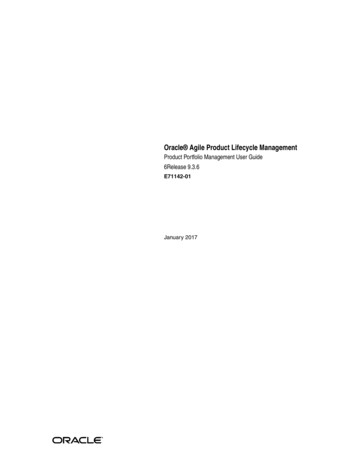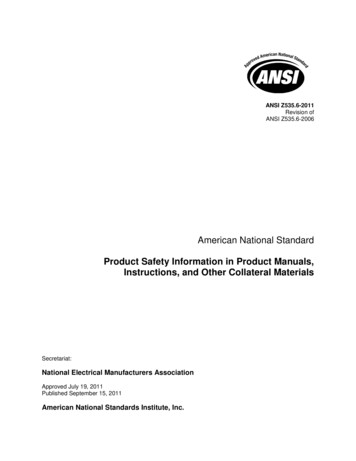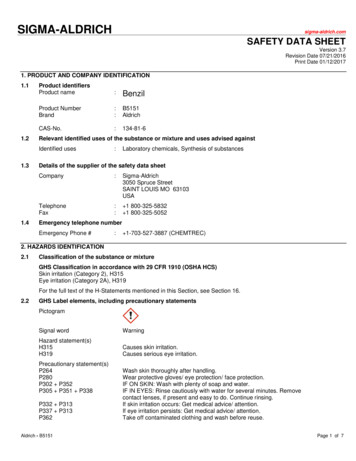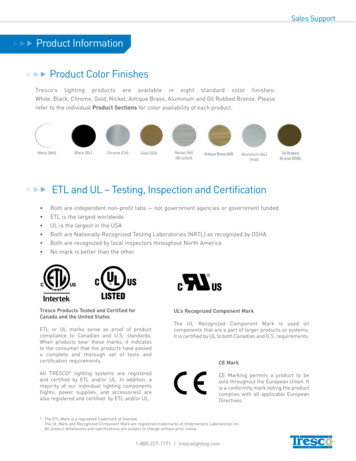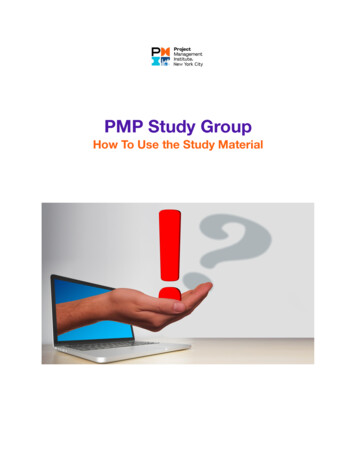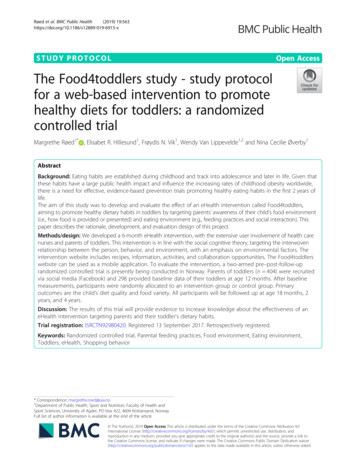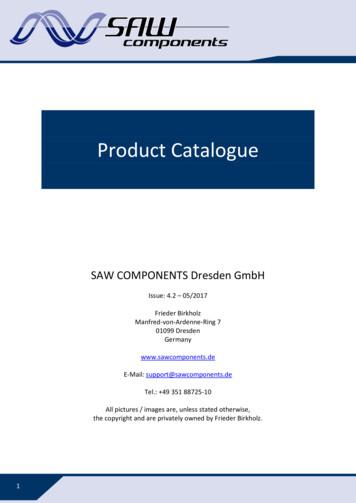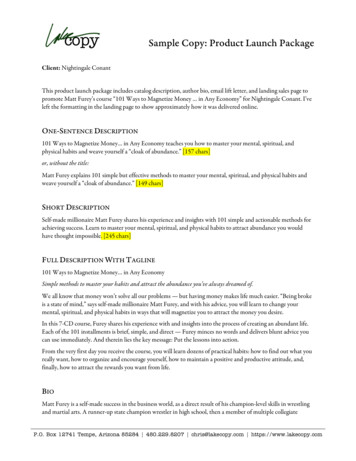
Transcription
A Study on the Product Life Cycle of Samsung Smartphone‘s in IndiaA Study on the Product Life Cycle of Samsung Smartphone’s in IndiaDibyajyoti MohapatraAsst. Prof. Marketing Management, Srusti Academy of Management, BhubaneswarAbstract : This Mini Project is about a study on theproduct life cycle of Samsung Galaxy in India and themarketing strategy it has used for its smart devices in theSmartphone market. The project will look into productsintroduced within the last two years, its mission and goalsand some of the key challenges it faces today. Then it willcontinue in exploring the marketing mix of SamsungSmartphone in their introduction stages, to have a deeperunderstanding on how Samsung has differentiate itselfusing the four components of the marketing mix to gain anadvantage over its components. Further we will see howSamsung recognizes every need in the market and how itoffers products for different customer segment. Samsung’ssuccessful growth strategy in mobile phone business.Keywords : Product, Product Life Cycle, Segmentation(types), Features, Popularity, Competitors.I. INTRODUCTIONWhen a new product is being introduced in to a market,it normally undergoes a series of step in the market;these steps are introduction growth, maturity and lastlythe decline stage. These steps follow each otherchronologically and thus referred to as the product lifecycle (PLC). The PLC sequence or series is closelylinked with the dynamics in the market environment andhas subsequent effects on the product marketing mix andmarketing strategies. Marketing is about creatingmarkets by satisfying target customers‗ needs and wantsbetter than competitors. Marketing is all about product,the product is a bundle of satisfaction that a customerbuys. The marketing definition of a product is more thanjust what the manufacturer understands it to be.In this industry, of fierce competition, the companieshave been forced to come up with very creativetechnological innovation and winning marketingstrategies. When iPhone was launched by Apple Inc. in2007, they created the Smartphone market for theaverage consumers, before that the product wastargeting only business users. From then Apples' iPhoneand Android phones, which are offered by Samsung,HTC and Nokia have tried their best in competing in thisever changing high-tech market and so far havequalified to be the big players in the Smartphoneindustry.1.1 OBJECTIVE OF THE STUDYTo study the PLCTo study the SegmentationTo study the PLC of Samsung GalaxyTo know the top brands To study the issues/challengesII. PRODUCTAccording to Peter Drucker, so long as a product is notbrought and consumed, it remains a raw material or atbest an intermediate. The product is almost always acombination of tangible and intangible benefits. Forexample, a refrigerator is not just merely steel, plastic,Freon gas, brand name, number of doors and so on, butalso involves factors like after sales service, delivery andinstallation, assistances in purchase of the product,dealer network, and services. It also connotes status indeveloping countries. It is the same with products likeTV, music system, automobiles, personal product, andservices like banks, airlines, telephone, courier, and soon.III. PRODUCT LIFE CYCLEAs consumers, we buy millions of products every year.And just like us, these products have a life cycle. Older,long-established products eventually become lesspopular, while in contrast, the demand for new, moremodern goods usually increases quite rapidly after theyare launched.Because most companies understand the differentproduct life cycle stages, and that the products they sellall have a limited lifespan, the majority of them willinvest heavily in new product development in order tomake sure that their businesses continue to grow.3.1Product Life Cycle Stages ExplainedThe product life cycle has 4 very clearly defined stages,each with its own characteristics that mean differentthings for business that are trying to manage the lifecycle of their particular products.a.Introduction Stage – This stage of the cyclecould be the most expensive for a company launching anew product. The size of the market for the product isNational Seminar on ―Emerging Trends in Management & Information Technology‖ (ETM&IT-2016)ISBN. 978-93-81692-07-2, Rourkela Institute of Management Studies, Rourkela, 20 th February, 201641
A Study on the Product Life Cycle of Samsung Smartphone‘s in Indiasmall, which means sales are low, although they will beincreasing. On the other hand, the cost of things likeresearch and development, consumer testing, and themarketing needed to launch the product can be veryhigh, especially if it‘s a competitive sector.b.Growth Stage – The growth stage is typicallycharacterized by a strong growth in sales and profits,and because the company can start to benefit fromeconomies of scale in production, the profit margins, aswell as the overall amount of profit, will increase. Thismakes it possible for businesses to invest more money inthe promotional activity to maximize the potential ofthis growth stage.c.Maturity Stage – During the maturity stage,the product is established and the aim for themanufacturer is now to maintain the market share theyhave built up. This is probably the most competitivetime for most products and businesses need to investwisely in any marketing they undertake. They also needto consider any product modifications or improvementsto the production process which might give them acompetitive advantage.d.Decline Stage – Eventually, the market for aproduct will start to shrink, and this is what‘s known asthe decline stage. This shrinkage could be due to themarket becoming saturated (i.e. all the customers whowill buy the product have already purchased it), orbecause the consumers are switching to a different typeof product. While this decline may be inevitable, it maystill be possible for companies to make some profit byswitching to less-expensive production methods andcheaper markets.Product Life Cycle ExamplesIt‘s possible to provide examples of various products toillustrate the different stages of the product life cyclemore clearly. Here is the example of watching recordedtelevision and the various stages of each method: Introduction – 3D TVsGrowth – Blueray discs/DVRMaturity – DVDDecline – Video cassetteThe idea of the product life cycle has been around forsome time, and it is an important principlemanufacturers need to understand in order to make aprofit and stay in business.However, the key to successful manufacturing is not justunderstanding, this life cycle, but also proactivelymanaging products throughout their lifetime, applyingthe appropriate resources and sales and marketingstrategies, depending on what stage products are at inthe cycle.IV. SAMSUNG: AT A GLANCEbecome the world‘s largest electronics company, andnow the largest manufacturer of mobile phones. Thecompany headquarters are located in Seoul andworldwide Samsung employ 200,000 plus workers.Samsung account for around one fifth of South Korea‘stotal exports, and it has grown to have a significantinfluence on not only the country‘s economicdevelopment but also its media, culture and politics – animpressive achievement for what was originally a smalltrading company specialising in groceries.For Samsung Electronics, 2003 was a watershed year. Itsuccessfully positioned itself as one of the world‘s bestmobile phone manufacturers and its products werefeatured all over the media. Many were calling itsmobile phones as ―the best gift for Christmas‖ or cation Business is a Business unit whichdeals with telecommunication. The parent of Samsung isSamsung Electronics. The president of Samsung isGeesung Choi. The products Samsung manufacturesmobile phones, smart phones, telecommunicationssystems, MP3 Players, Laptop computers etc.V. SAMSUNG SMART PHONEA Smartphone (or smart phone) is a mobile phone withan advanced mobile operating system which combinesfeatures of a personal computer operating system withother features useful for mobile or handheld use. Theytypically combine the features of a cell phone with thoseof other popular mobile devices, such as personal digitalassistant (PDA), media player and GPS navigation unit.Most Smartphone can access the Internet, havea touchscreen userinterface,canrunthirdparty apps, music players and are camera phones. InNovember 2009, the Bada operating system forsmartphones was announced by Samsung. The firstBada-based phone was the Samsung Wave S8500,released in June 2010. Samsung shipped 4.5 millionphones running Bada in Q2 of 2011. Most Smartphonesproduced from 2012 onwards also have high-speedmobile broadband 4G LTE internet, motion sensors,and mobile payment mechanisms. In 2013, Bada mergedwith a similar platform called Tizen. In 2014, sales ofsmartphones worldwide topped 1.2 billion, which wasup 28% from 2013.Example : Samsung GalaxyThe Samsung Galaxy, known as Samsung GT-I7500 insomecountries,isamobilephone manufactured by Samsung that used the opensource Android operating system. It was announced on27 April 2009. It is succeeded by the Samsung i5700Samsung Galaxy former logo used from 2010 until2015. It is used as of release of Samsung Galaxy J1,Samsung Galaxy A8 and Samsung Galaxy Xcover 3.Samsung Galaxy Note series, Samsung Galaxy Grand,Ace, Samsung Galaxy S series, Mega, Mini, Young,Phablet, smartphones, Tablets etc, with Android asSamsung was founded in 1938 by Lee-Byung and wasoriginally called Samsung Sanhoe. It has risen toNational Seminar on ―Emerging Trends in Management & Information Technology‖ (ETM&IT-2016)ISBN. 978-93-81692-07-2, Rourkela Institute of Management Studies, Rourkela, 20 th February, 201642
A Study on the Product Life Cycle of Samsung Smartphone‘s in IndiaOperating system along with touch screen and stylus asinput.customers to behave in line with the economic interestof the business (McDonald, 2013).VI. MARKETING MIXSamsung uses different promotional tools acrossdifferent media platforms to promote its smartphones.They use the television, print advertising, internet socialmedia and outdoor media.In order to find out which strategy Samsung used toachieve its leading position in the smartphone market, Iwill take a look at its marketing mix. The marketing mixwill point out the strategic choices of the company.Marketing mix is referred to blend of product, pricing,promotion distribution strategies made to produce amutual satisfying exchange with the target market(Hutchison, 2009). The marketing mix is a synonym of4ps, which is made of the four relevant components ofall product strategy. These are Product, Promotion, Priceand Place. They hold the opportunity for the company todifferentiate. (Borden, 1964). The four ―P‖s of product,price, promotion and place constitute the offer that anorganization offers to the business. If this offers suitswell the consumers‘ needs, it should lead to sales. Inaddition, if it‘s sufficiently managed, these sales shouldadd profit to the business. (McDonald, 2013) suppliersneed to understand the attributes and benefits thebuyers‘ value so that they customize each ―P‖ to theirneeds, and the mix of the elements that will be appealingto the buyers. (Young, 2011).6.1ProductThese are the goods and services that a company offersto the target market. the product in marketing refers toall activities relating to the product development,keeping in mind that there is a market for the product, ithas to be appealing; it differentiates from other productsexisting in the market, and it can be produced at anaffordable competitive price. Samsung‘s smartphonesevolve beyond its limitation in slim phones to embodythe perfect combination of comfort, simplicity andsophistication. All their unique customized smartphonescome with outstanding features. Products vary greatly inSamsung‘s phone department. They have a number ofGalaxy smartphones, Galaxy S4 being their fourthgeneration. Samsung galaxy Series are Android basedand many more.6.2PromotionThese are all types of communications a marketer mayuse to give information to different people about theproduct (Borden 1964). All the promotion activities aredesigned to communicate with the market and thuspromotes the sale of the products. Promotion providesinformation that will assist customers in making adecision to purchase a product. This includes:advertising. Public relations, personal selling and salespromotion. These are important tools that supportpositioning within the various market a company wishesto address (McDonald, 2013). It is also seen asinforming, motivating the customers and reminding theconsumers to purchase the product (Hutchison, 2009).Promotion is an essential tool for solving organizationalproblems like enhancing market position or persuading6.3PriceThis is the amount for what the product is to be paid.(Borden, 1964). Hutchison (2009) referred price as whatcustomers will exchange for product. Among the fourcomponents, price is determined as an importantvariable since it is one of the key determinants of aproduct value. Price is thus one of the evaluative criteriaused by consumers, as are the cost incurred in buyingand owning or using the product (McDonald, 2013). Healso noted that the price is very difficult aspect of themarketing mix to manage. McDonald (2013) urges thatto maintain the integrity of prices; the company shouldimplement a sound pricing strategy; this will support thecompany‘s overall marketing strategy and profitability.After manufacturing innovative and cost effectivephones worldwide for a long time, Samsung has beenable to learn what is required to stay on top of itsindustry. It has not allowed Apple Inc. to grow inmarkets like Asia and developing countries like Indiadue to its price policy. This is the results ofmanufacturing wide range of products with differentprice range.6.4PlacePlace is also known as distribution. This is to how theproduct finally re
A Study on the Product Life Cycle of Samsung Smartphone‘s in India National Seminar on ―Emerging Trends in Management & Information Technology‖ (ETM&IT-2016) ISBN. 978-93-81692-07-2, Rourkela Institute of Management Studies, Rourkela, 20 th February, 2016
